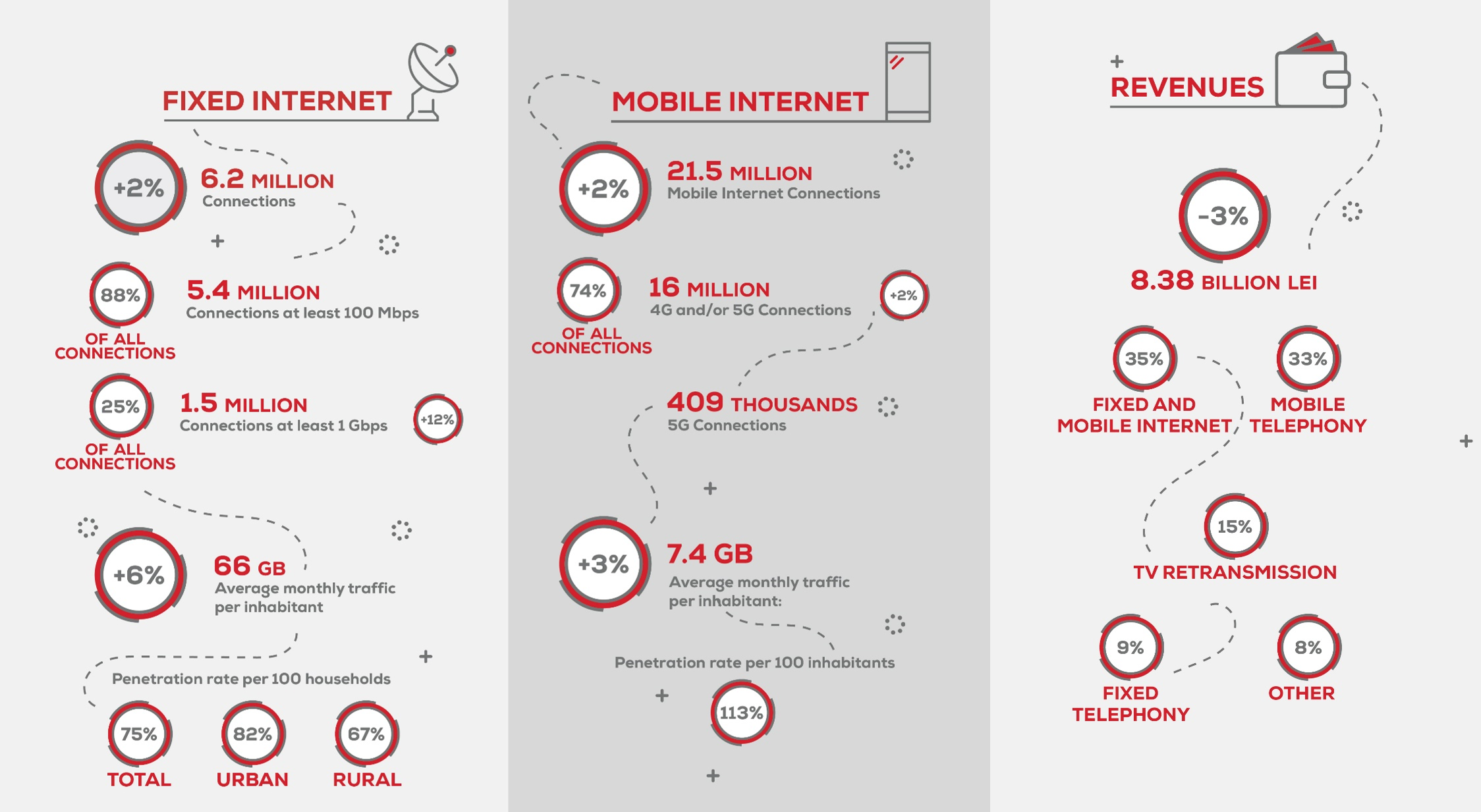A quarter of fixed internet connections enable at least 1 Gbps
09.12.2022

Gigabit connections increased by 12% in the first half of 2022, exceeding 1.5 million, reaching 25% of the fixed internet connections. In the same period, the number of 5G connections exceeded 400 thousand, i.e. only 2% of the mobile Internet connections, according to the statistical data report for the first semester of 2022. An infographic is available here.
"The growing availability of fiber optic networks is fueling the large-scale uptake of ultra-fast connections, with speeds of at least 1 Gbps, which are required for the Gigabit economy and society. Moreover, the number of connections enabling at least 100 Mbps in rural areas is growing quite impressively: in the last 2 years, the number of these connections has doubled, from 1 million to almost 2 million, also due to the roll-out of optical fiber", said Eduard LOVIN, vice-president of ANCOM.
Â
ANCOM's report on the telecom market in the first half of 2022 is available in Romanian here. The main developments are presented below:
Fixed Internet
- +2% increase in the number of connections in the first 6 months, totalling 6.2 million, 88% of which enable speeds exceeding 100 Mbps;
- 25% of connections (1.5 million connections, up by +12%) enabled speeds of at least 1 Gbps
- The average monthly traffic reached 66 GB per inhabitant (+6%), i.e. 2.2 GB/day
- At a national level, Â the penetration rate per 100 households reached 75% (81% in urban areas and 66% in rural areas), with a higher growth rate of the number of connections in rural areas (+3%) that in urban areas (+1%)
- The 3 largest providers, by number of connections, were: RCS&RDS (65%), Â Orange Group (21%) and Vodafone (12%).
Mobile Internet
- The total number of active connections (21.5 million) increased at a pace similar to that of fixed internet growth (+2%), with 74% of them enabling 4G and/or 5G (16 million)
- The number of 5G connections increased almost 8 times compared to the same period of 2021, exceeding 400 thousand connections
- Almost 20 million connections include mobile telephony, the rest being dedicated to mobile internet, with modem/card/USB access
- The average monthly traffic was 7.4 GB per inhabitant, i.e. almost 250 MB/day
- The 3 largest providers, by number of connections, were: Orange Group (40%), Vodafone (24%) and RCS&RDS (22%)
Mobile telephony
- 23 million active mobile SIM cards, 63% of which were subscription-based and 37% were based on a prepaid card
- The number of active SIM cards based on a mobile telephony subscription increased by 3%, while the number of prepaid SIM cards decreased by 4%
- Total voice traffic decreased by 3% to 32.5 billion minutes, while the average mobile traffic per inhabitant was 4 hours and 45 minutes/month, respectively, 20 SMS/month
- Based on the number of active SIM cards as of mid-2022, the Orange Group had a market share of 39%, Vodafone 29%, and RCS&RDS 19%
Television
- The number of subscribers to TV services was constant, i.e. 7.8 million
- The uptake of cable retransmission services kept growing (+2%, totaling 6.4 million subscribers), while the decline of satellite/DTH services continued (-11%, totaling 1.3 million)
- Based on the total number of subscribers by mid-2022, RCS&RDS had a market share of 67%, Orange Group 15%, and Vodafone 11%
Telecom revenues
- Revenues from the telecom sector decreased by 3% in the first half of 2022, totaling 8.38 billion lei (1.69 billion euros)
- Fixed and mobile Internet generated 35% of total revenues, mobile telephony 33%, retransmission of TV programs 15%, fixed telephony 9%, and other types of networks/services 8%
- The largest 3 providers based on the revenues obtained from electronic communications, were: Orange Group  (40%), Vodafone (24%) and RCS&RDS (23%)
Statistical data report
ANCOM draws up the statistical data report on the electronic communications market in Romania for the first semester of 2022 based on the statistical data reported half-yearly by the providers who have the obligation to transmit to ANCOM the values of the indicators corresponding to all the categories of services according to Decision no. 333/2013 and is available here.



 top
top
